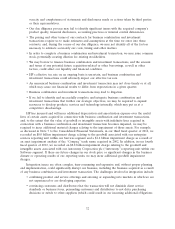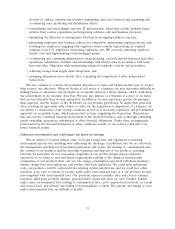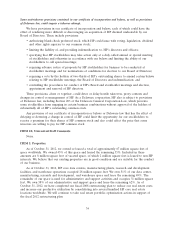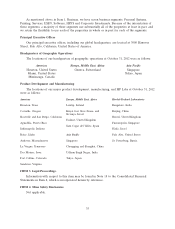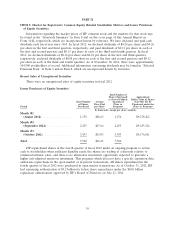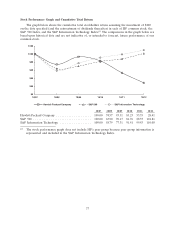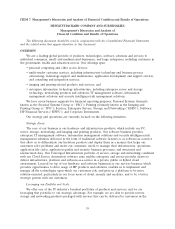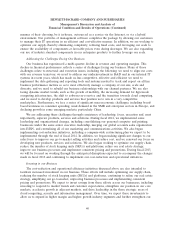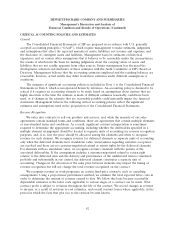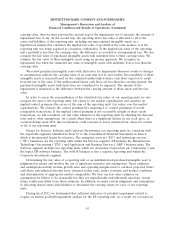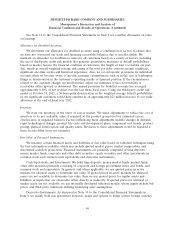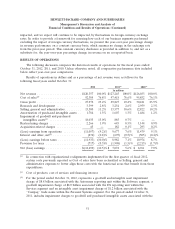HP 2012 Annual Report Download - page 50
Download and view the complete annual report
Please find page 50 of the 2012 HP annual report below. You can navigate through the pages in the report by either clicking on the pages listed below, or by using the keyword search tool below to find specific information within the annual report.HEWLETT-PACKARD COMPANY AND SUBSIDIARIES
Management’s Discussion and Analysis of
Financial Condition and Results of Operations (Continued)
CRITICAL ACCOUNTING POLICIES AND ESTIMATES
General
The Consolidated Financial Statements of HP are prepared in accordance with U.S. generally
accepted accounting principles (‘‘GAAP’’), which require management to make estimates, judgments
and assumptions that affect the reported amounts of assets, liabilities, net revenue and expenses, and
the disclosure of contingent assets and liabilities. Management bases its estimates on historical
experience and on various other assumptions that it believes to be reasonable under the circumstances,
the results of which form the basis for making judgments about the carrying values of assets and
liabilities that are not readily apparent from other sources. Senior management has discussed the
development, selection and disclosure of these estimates with the Audit Committee of HP’s Board of
Directors. Management believes that the accounting estimates employed and the resulting balances are
reasonable; however, actual results may differ from these estimates under different assumptions or
conditions.
The summary of significant accounting policies is included in Note 1 to the Consolidated Financial
Statements in Item 8, which is incorporated herein by reference. An accounting policy is deemed to be
critical if it requires an accounting estimate to be made based on assumptions about matters that are
highly uncertain at the time the estimate is made, if different estimates reasonably could have been
used, or if changes in the estimate that are reasonably possible could materially impact the financial
statements. Management believes the following critical accounting policies reflect the significant
estimates and assumptions used in the preparation of the Consolidated Financial Statements.
Revenue Recognition
We enter into contracts to sell our products and services, and, while the majority of our sales
agreements contain standard terms and conditions, there are agreements that contain multiple elements
or non-standard terms and conditions. As a result, significant contract interpretation is sometimes
required to determine the appropriate accounting, including whether the deliverables specified in a
multiple element arrangement should be treated as separate units of accounting for revenue recognition
purposes, and, if so, how the price should be allocated among the elements and when to recognize
revenue for each element. We recognize revenue for delivered elements as separate units of accounting
only when the delivered elements have standalone value, uncertainties regarding customer acceptance
are resolved and there are no customer-negotiated refund or return rights for the delivered elements.
For elements with no standalone value, we recognize revenue consistent with the pattern of the
associated deliverables. If the arrangement includes a customer-negotiated refund or return right
relative to the delivered item and the delivery and performance of the undelivered item is considered
probable and substantially in our control, the delivered element constitutes a separate unit of
accounting. Changes in the allocation of the sales price between elements may impact the timing of
revenue recognition but will not change the total revenue recognized on the contract.
We recognize revenue as work progresses on certain fixed-price contracts, such as consulting
arrangements. Using a proportional performance method, we estimate the total expected labor costs in
order to determine the amount of revenue earned to date. We follow this basis because reasonably
dependable estimates of the labor costs applicable to various stages of a contract can be made. Total
contract profit is subject to revisions throughout the life of the contract. We record changes in revenue
to income, as a result of revisions to cost estimates, and overall contract losses where applicable, in the
period in which the facts that give rise to the revision become known.
42


